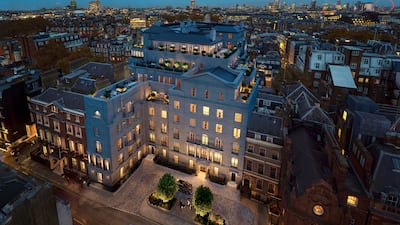There’s a reason Mayfair is the most expensive property on the Monopoly board. The purple square right at the end of the clockwise circuit is worth £400 and should the owner build a hotel on it, he or she will be able to charge £1,500 to players who land on it.
In real life, the area of London that’s bordered by Regent Street, Oxford Street, Park Lane and Piccadilly enjoys much the same relative prestige and value. For hundreds of years, an address in London’s Mayfair conveyed many things, but mostly that you were upper-class and wealthy.
Indeed, the 18th century British writer, philosopher and cleric Sydney Smith once wrote that, as an area, Mayfair held “more intelligence, human ability, to say nothing of wealth and beauty than the world ever collected in so small a space before”.
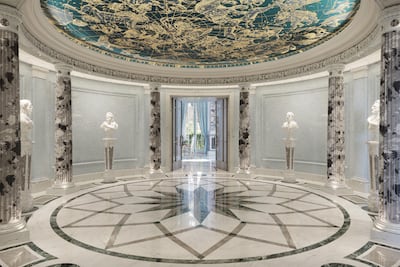
Today, some of the most elegant and expensive real estate London has to offer is found in Mayfair and in recent years the pace of regeneration in the southern part of the area has seen billions of pounds pour into new developments, as well as upgraded and refurbished real estate. A survey by The National shows the majority of mega-developments now wedged into the bottom corner of the area below South St.
“The whole of South Mayfair has been undergoing a massive transformation, with new residential buildings, enhanced public realm and former commercial use town houses and mansions now being converted back into homes or luxury hotels,” Peter Wetherell, the founder and chief executive of the Mayfair-based super prime agents, Wetherell, told The National.
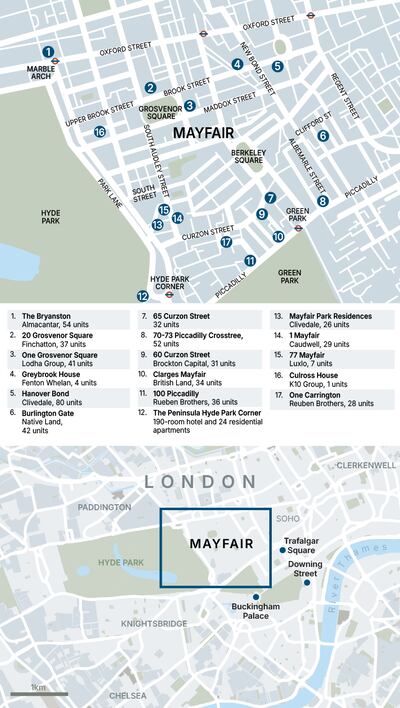
A colourful history
It wasn’t always so. As the name suggests, the area once played host to a very popular fair which took place at the beginning of May. The first recorded instance of the May Fair was in 1560, but it’s thought to have been held as far back as the 13th century, when that area of London was still green fields and pastures.
Two centuries later, and things had got out of hand. The May Fair, which aside from numerous food and drink stalls, had attractions including exotic animals, boxers, jugglers, dancers, acrobats and fire-eaters. But it also built a reputation for chaos, danger and a sleazy element. In 1702, a constable was killed in a fight and six years later a formal complaint was made to Queen Anne about the “many loose, idle and disorderly persons” gathering at the May Fair to “commit lewd and disorderly practices”.
But 1764, the curtain came down on the May Fair. This was partly because of the strong objection and personal influence of the Earl of Coventry who built a house on Piccadilly whose land backed on to the fair, but also because urban London was spreading westward and the meadows and fields were giving way to houses and formally laid-out streets. As such, the area known for the May Fair, became the affluent area of Mayfair.
For decades there remained some “pockets of colour”, especially in the south of Mayfair, just north of Piccadilly and south of Brook Street. It was here that a two-storey market-house – containing a butchers’ stalls downstairs and a theatre upstairs – was built on land that was leased by the architect Edward Shepherd. As such, this area gained the name Shepherd Market.
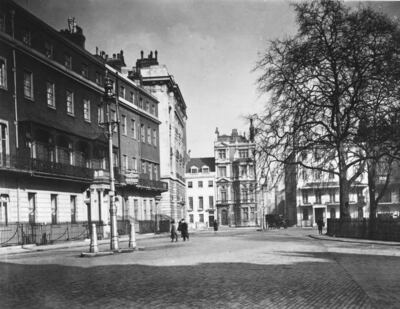
Some of this was failure to recover from ravages of the early 20th century. Given the loss of life in the First World War, the labour pool of servants was reduced, wages rose and the owners of the grand houses of Mayfair could no longer afford to maintain them. As such, many became foreign embassies, which are still there today. Some were converted to hotels, while others became commercial offices, a process that was accelerated during the Blitz of World War Two, when many firms moved out of the City of London to avoid German bombs.
By the 1990s, South Mayfair was a curious mix. Law chambers, hedge funds and wealthy residential buildings rubbed shoulders alongside what estate agents termed more “colourful” areas – especially around Shepherd Market. “But it had a lot of character and a lot of charm,” Charles Lloyd, head of Beauchamp Estates’ Mayfair office told The National. “People have always thought posh about Mayfair, but Shepherd Market and Curzon Street down to Piccadilly was always colourful.”
Much of that colour nowadays is the colour of money, as the part of Mayfair south of Grosvenor and Berkeley Squares has seen development cash pour in, which has really provided a lift to the area. There is now a raft of upmarket projects across Mayfair, representing a development renaissance led by no fewer than 12 prime, super and ultra-prime developers, including British Land, Caudwell Properties, K10 Group and Luxlo.
'Most exciting development in 300 years'
The grandest development currently nearing completion in South Mayfair is 1 Mayfair at the southern end of South Audley Street, which Mr Wetherell describes as the “most exciting new development in Mayfair in 300 years, since 1720 and the original building of Grosvenor Square”. The 300,000 square foot ultra-luxurious building crafted in Portland stone occupies half of an entire city block with facades fronting on to South Audley Street, Hill Street and Waverton Street.
The creation of the mobile phone entrepreneur and billionaire property developer, John Caudwell, 1 Mayfair is a unique collection of 29 residences, all with stately home-inspired interiors. Unit prices at 1 Mayfair start at £35 million ($45.9 million) and the building has high-end amenities that would be the envy of the world’s most luxurious hotels. The sales process at 1 Mayfair has only just begun, but already there are 450 registered applicants – 16 possible buyers for each home – proving the high demand for super and ultra-prime residential real estate in this part of Mayfair.

“For a long time, South Audley Street was blighted by the city block bordered by Hill Street and Waverton Street, which was dominated by a vast multistorey car park surrounded by a mismatch of other properties,” Lars Christiaanse, group director of sales at Caudwell told The National. “All of this has now been cleared away and in its place Caudwell are building 1 Mayfair, which is set to be one of the most exclusive and luxurious residential schemes in the world. Alongside the main apartment building is a terrace of grand town houses, complete with a central garden and leisure amenities. It has been the catalyst for regeneration which has rippled out across the local area.”
That’s often the case with regeneration projects – they spread through an area as values increase. Suddenly neighbourhoods, like Shepherd Market and arguably much of South Mayfair, become more fertile investment opportunities. Indeed, just across the road from 1 Mayfair, the former Naval Club at 38 Hill Street is being reborn as a luxury boutique hotel.
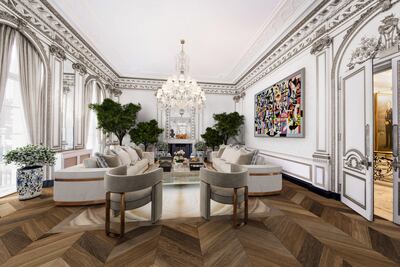
Likewise, the regeneration ripple has spread south towards Piccadilly and Green Park, sweeping Shepherd Market along with it. As such, what was a slightly seedy enclave of South Mayfair 25 years ago is now a magnet for trendy boutiques and coffee shops. “You’ve got this big regeneration going on in and around Shepherd Market and ultimately that helps to uplift the values of everything else in the immediate area,” Mr Lloyd said. “It also offers slightly better value in terms of price per square foot when compared to other areas. Shepherd Market represents good value.”
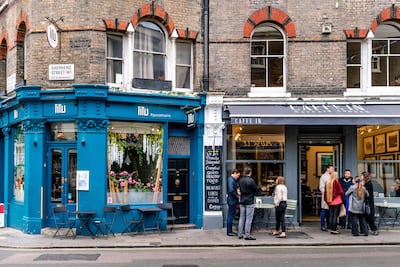
The regeneration has moved eastward to developments like 60 Curzon, where apartments start at £3 million, and on to Piccadilly itself, the grand London road that connects Piccadilly Circus with Hyde Park Corner and is home to the Ritz hotel and luxury retailer Fortnum and Mason. It’s on Piccadilly that the property magnets Simon and David Reuben have developed the Cambridge House, formerly a military club, which is set to open late next year as a 102-room hotel and a private members’ club.
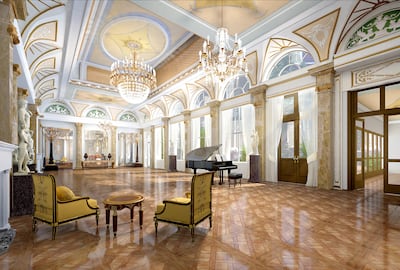
The involvement of the Reuben Brothers in South Mayfair doesn’t stop there. They are investing £1 billion into regeneration projects within their 0.5-hectare slice of what’s called the Piccadilly Estate. This includes the residential development at One Carrington, as well as a good chunk of Shepherd Market, including the private club at 5 Hertford Street, which is rumoured to be frequented by the likes of Harry Styles, Mick Jagger and Leonardo DiCaprio. “If you look at the development of One Carrington – that was the old NCP car park. That’s transforming that corner of Mayfair,” Mr Lloyd said.
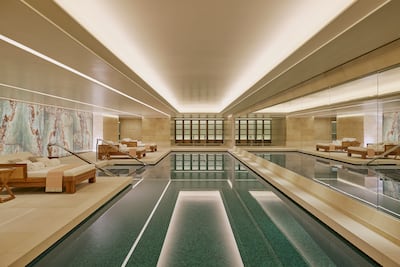
Supply squeeze
Property values in Mayfair have proved resilient as well, with a fifth-floor, two-bedroomed 2,145 square foot apartment at 47 Grosvenor Square recently selling for £7.85 million. Indeed, the trophy property market in Mayfair has doubled in the past year, according to Wetherell, and the area is seeing the strongest property value gains in a decade, while much of the rest of London’s residential real estate market is currently in the doldrums.
In Mayfair, the first eight months of this year saw 71 sales in the prime and super prime categories – with 11 homes priced above £10 million. That compares will 80 deals over the whole of 2023, with just five topping £10 million. Buyers paying above £15 million tend to come from the US, India and the Middle East, including purchasers from the UAE, Saudi Arabia and Qatar. For the most expensive homes in Mayfair, buyers are usually Middle Eastern or Indian in origin.
For Mr Wetherell, the strength behind property values in Mayfair at the moment is down to the good, old-fashioned economics of supply and demand. The plentiful supply of ultra-prime new houses in the area over the past seven years has now largely been snapped up by the world’s billionaires, yet the demand for these high-end luxury residences persists.
“Pricing for new trophy homes in Mayfair has the potential to achieve over £12,000 per square foot over the next few years, exceeding the record £10,000 per square foot prices already achieved at No.1 Grosvenor Square," he said. "This new level of pricing will make Mayfair the most valuable real estate address in the world by far.”

As such, time is of the essence for the ultra-wealthy on the hunt for a super prime luxury home in Mayfair. Westminster City Council’s development plan for the next 20 years means newly builds will have a unit restriction of 2,150 square feet and there are rules preventing units from being amalgamated. As such, the undersupply of large luxury homes in Mayfair is likely to continue even as new developments spring up. Mr Wetherell says this is very much a “buy now while stocks last” situation.
“Each decade property values in Mayfair have risen regardless of whether value in other London addresses have slipped,” Mr Christiaanse told The National. “Discerning buyers from around the world view Mayfair as both a good lifestyle choice for a London home and an excellent long-term financial investment.”
